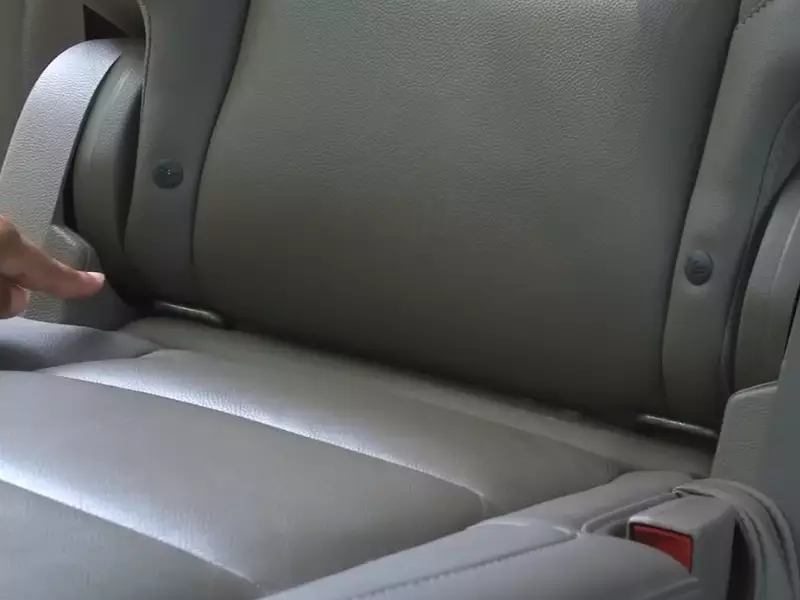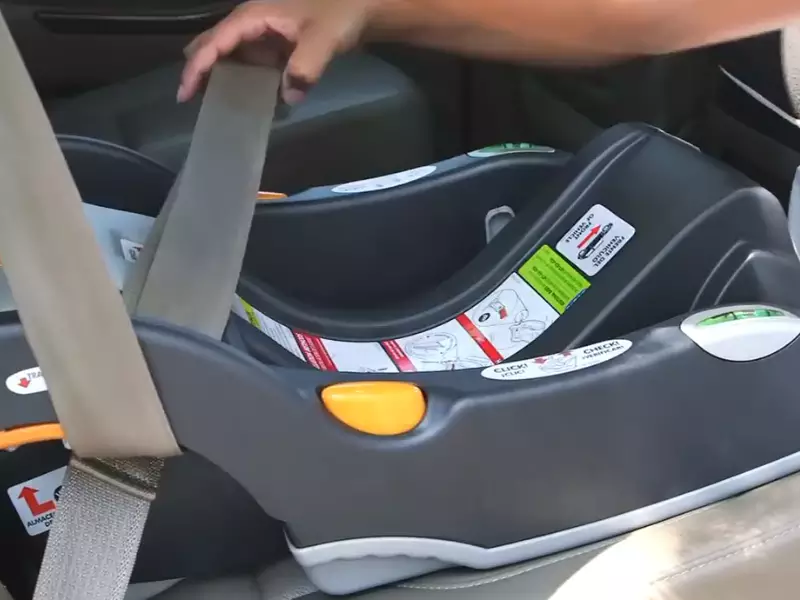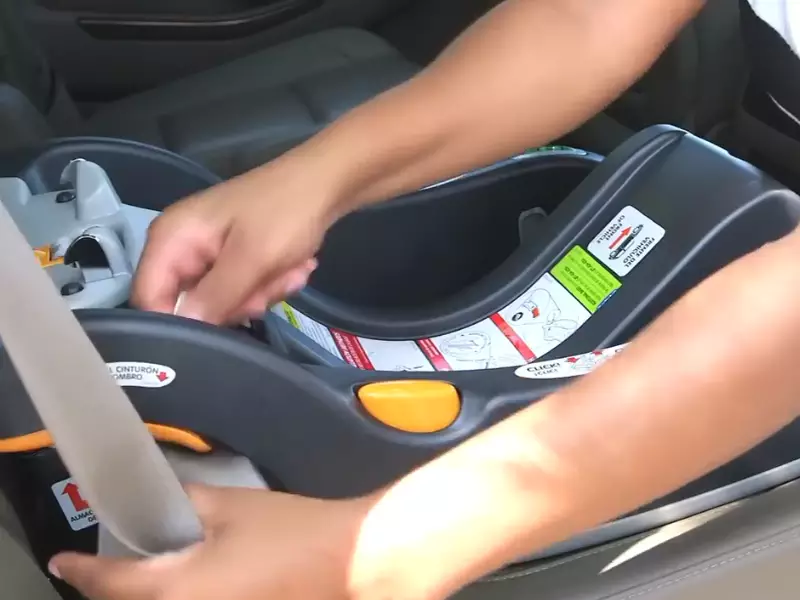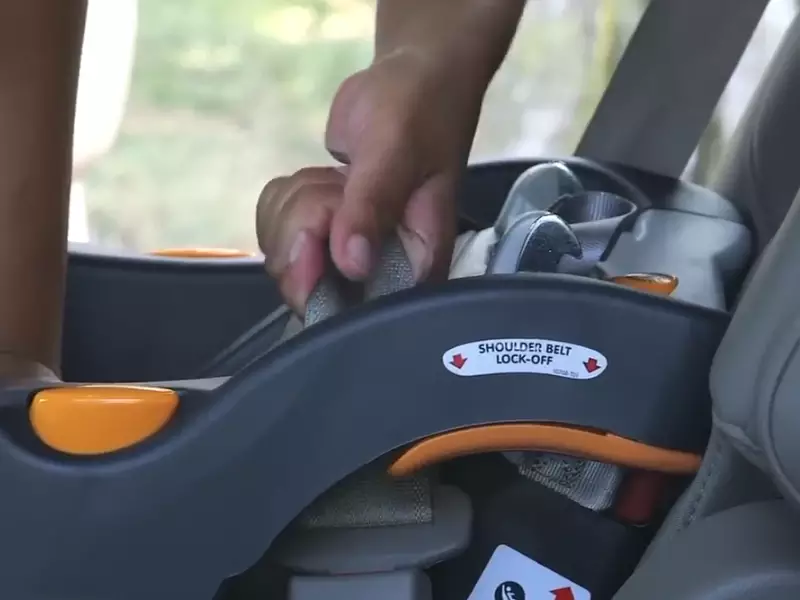To install a car seat base, follow these steps: position the base in your car’s back seat, thread the seat belt through the base, and tighten the seat belt to secure the base in place. Also, make sure the seat is at the correct angle before securing it.
Once the base is installed, attach the car seat to the base securely. Installing a car seat base ensures the safety of your child and provides a stable foundation for the car seat. Following the correct installation process is crucial to ensure that the car seat is properly secured and ready for use.

Understanding The Basics Of Carseat Base Installation
When it comes to ensuring your child’s safety while traveling, installing a car seat base correctly is of utmost importance. Even seasoned parents can find the process overwhelming, especially with the variety of car seat base options available. In this section, we will dive into the basics of car seat base installation, highlighting the different types of carseat bases and how to select the right one for your car.
Different Types of Carseat Bases
To begin, let’s explore the various types of carseat bases available in the market today.
Infant Carriers
Infant carriers are specifically designed for newborns and infants. These carseat bases often come with a detachable carrier that allows you to transfer your sleeping baby without unnecessary disturbance. Infant carriers are usually lightweight and portable, making them an excellent choice for parents on the go. They offer convenience, safety, and comfort for your little one.
Convertible Car Seats
Convertible car seats are a popular option among parents as they provide longevity and adaptability. These carseat bases can be adjusted to accommodate rear-facing positions for infants and can later transition to forward-facing positions as your child grows. It is essential to ensure that these carseat bases fit snugly and securely in your car, providing maximum protection for your child at every stage.
All-in-One Car Seats
All-in-one car seats are designed to cover all the bases, providing the convenience of both infant carriers and convertible car seats in one package. These carseat bases can be used from infancy to toddlerhood, accommodating various weight ranges and allowing for multiple installation options. Investing in an all-in-one car seat can save you money and time as your child grows.
Selecting the Right Carseat Base for Your Car
When selecting a carseat base for your car, there are a few key factors to consider to ensure a proper fit and installation. Firstly, you need to make sure that the carseat base you choose is compatible with your vehicle. Check the manufacturer’s guidelines and recommendations to find out which carseat bases are suitable for your car make and model.
Additionally, consider the weight range of the carseat base to ensure it can accommodate your child’s growth. Check if the carseat base offers adjustable recline positions and whether it has a clear and straightforward installation process.
It is also worth noting that different carseat bases may have different installation methods. Some carseat bases use a seatbelt installation, while others utilize the LATCH system. The LATCH system, which stands for Lower Anchors and Tethers for Children, provides an alternative method of installing the carseat base using your car’s built-in anchors. Ensure you understand the installation method of the carseat base you choose and follow the manufacturer’s instructions precisely.
In conclusion, understanding the basics of carseat base installation is crucial for ensuring your child’s safety while traveling. Familiarize yourself with the different types of carseat bases available, including infant carriers, convertible car seats, and all-in-one car seats. Selecting the right carseat base for your car involves considering compatibility, weight range, installation methods, and manufacturer’s guidelines. By following these guidelines, you can rest assured that your little one is safe and secure during your journeys together.
Preparing For Carseat Base Installation
Before you can safely and securely install a carseat base for your little one, it’s important to properly prepare yourself for the installation process. This involves familiarizing yourself with the carseat base components, reading the carseat base installation manual, and ensuring proper car seat positioning. By following these steps, you can ensure that your child’s carseat is installed correctly and optimize their safety while traveling.

Familiarizing Yourself with the Carseat Base Components
Before you start the actual installation process, it’s essential to familiarize yourself with the different components of the carseat base. Each carseat model may have its unique set of components that are necessary for proper installation. By understanding the various parts of the carseat base, you will have a better understanding of how they fit together and how they interact with your vehicle.
Here are some common components you may find:
| Components | Description |
|---|---|
| LATCH connectors | These connectors securely attach the carseat base to the vehicle’s anchors. |
| Adjustment knobs or levers | These knobs or levers allow you to adjust the carseat base angles for proper installation. |
| Seat belt lock-offs | These lock the seat belt in place to ensure a tight and secure installation. |
| Buckle connectors | These enable you to attach the carseat base to the vehicle using the seat belt. |
Reading the Carseat Base Installation Manual
Now that you are familiar with the carseat base components, the next step is to carefully read the carseat base installation manual that came with your car seat. The manual provides specific instructions on how to install the carseat base correctly and ensures that you are following the manufacturer’s guidelines. Pay close attention to the recommended weight limits, age restrictions, and any specific installation instructions for your carseat’s model.
Ensuring Proper Car Seat Positioning
The final step before commencing the installation process is to ensure proper car seat positioning. This involves identifying the suitable location in your vehicle where the carseat base will be installed. Consult the carseat’s manual to determine the optimal spot, which is typically at the rear center seat or behind the passenger seat.
Keep in mind the following pointers while positioning the car seat:
- Make sure the car seat rear-facing indicator is level with the ground.
- Ensure that the car seat does not interfere with the front passenger seat and the driver’s ability to operate the vehicle.
- Check for sufficient legroom and headroom for your child’s comfort.
- Confirm that the car seat does not interfere with any airbags that may deploy in case of an accident.
By adhering to these guidelines, you can optimize your child’s safety and comfort while traveling by car.
Step-By-Step Guide To Installing A Carseat Base
Installing a carseat base correctly is crucial for ensuring the safety and security of your child while traveling. In this step-by-step guide, we will walk you through the process of installing a carseat base in your vehicle. Following these instructions will help you to securely install the carseat base and provide a stable foundation for the carseat.
Clearing the Car Seat Area
The first step in installing a carseat base is to clear the car seat area of any obstructions. Remove any items, such as toys or other objects, that may interfere with the installation process. Make sure the vehicle seat is clean and free from any debris or loose objects that could compromise the stability of the carseat base.
Positioning the Carseat Base
Once the car seat area is clear, position the carseat base in the desired location. Check the carseat manufacturer’s guidelines for specific instructions on how the carseat base should be positioned in your vehicle. Typically, the base should be placed in the rear seat of the vehicle, facing the rear. Ensure that the base is centered and aligned properly.
Securing the Base with the Seat Belt
With the carseat base properly positioned, it’s time to secure it in place using the seat belt. Fasten the seat belt through the designated belt path on the carseat base. Make sure the seat belt is pulled tightly and locked into place. Refer to your vehicle’s owner manual for instructions on how to properly secure the seat belt for carseat installation. Double check that the seat belt is securely fastened to prevent any movement or shifting of the carseat base.

Testing the Stability of the Installed Carseat Base
Once the carseat base is secured with the seat belt, it’s important to test the stability of the installation. Firmly grip the carseat base and try to move it side to side and front to back. The base should feel stable and secure, without excessive movement. If you notice any significant movement, adjust the installation or seek assistance from a certified carseat technician to ensure the carseat base is properly installed.
By following this step-by-step guide, you can confidently install a carseat base in your vehicle. Remember to always refer to the carseat manufacturer’s instructions and your vehicle’s owner manual for specific guidelines and recommendations. Proper installation of the carseat base is essential for the safety of your child while traveling.
Tips And Tricks For A Secure And Safe Installation
When it comes to the safety of your little one, installing a carseat base correctly is of utmost importance. A secure and safe installation ensures that your child is protected in the event of a car accident or sudden stop. In this article, we will focus on some valuable tips and tricks that will help you achieve a secure and safe installation for your carseat base.
Ensuring Proper Alignment and Tension of the Seat Belt
Proper alignment and tension of the seat belt are crucial to ensure a secure installation of the carseat base. Follow these steps to achieve the correct alignment and tension:
- Thread the seat belt through the designated path on the carseat base. Refer to the manufacturer’s instructions for the specific path.
- Make sure the seat belt is not twisted and is lying flat without any folds.
- Pull the seat belt tightly to remove any slack, but avoid overtightening as it can compromise the stability of the carseat base.
- Secure the seat belt in place, ensuring it is latched securely and locked in position.
Adjusting the Recline Angle of the Carseat Base
The proper recline angle of the carseat base is important for your baby’s comfort and safety. Follow these steps to adjust the recline angle:
- Consult the carseat base manual to determine the recommended recline angle for your child’s weight and age.
- Locate the recline adjustment mechanism on the carseat base.
- Adjust the recline angle of the carseat base according to the manufacturer’s instructions until it matches the recommended angle.
- Ensure that the bubble level indicator, if present, is within the acceptable range to ensure proper recline.
Checking for Movement and Loose Fittings
Regularly checking for any movement or loose fittings in your carseat base is essential to maintain a secure installation. Follow these steps to ensure there are no loose fittings:
| 1. | Place both hands on the carseat base and attempt to wiggle it side to side and front to back. There should be minimal movement. If you notice excessive movement, recheck and adjust as necessary. |
| 2. | Inspect all attachment points, including the seat belt, latch connectors, and base connectors, to ensure they are securely fastened and properly locked. |
| 3. | Regularly tighten any loose fittings or adjust them as needed to ensure the carseat base remains securely in place. |
By following these tips and tricks, you can achieve a secure and safe installation of your carseat base. Remember to consult the manufacturer’s instructions for specific guidelines and recommendations. Your child’s safety is worth the extra effort!
Common Mistakes To Avoid When Installing A Carseat Base
Installing a carseat base is a crucial step in ensuring the safety of your child during car journeys. However, many parents often unknowingly make common mistakes that can compromise the effectiveness of the carseat. To truly provide the maximum protection for your little one, it’s essential to be aware of these potential pitfalls. In this article, we will discuss three common mistakes to avoid when installing a carseat base, including not understanding the specific requirements for your car model, incorrect routing of the seat belt, and overlooking the angle indicator for proper installation.
Not Understanding the Specific Requirements for Your Car Model
One of the first mistakes parents make when installing a carseat base is not fully understanding the specific requirements for their car model. Each car can have slightly different latch systems or variations in seat belt structures, and it’s crucial to familiarize yourself with these specific requirements for your car. Most carseat manufacturers provide detailed instructions and car compatibility lists that should be thoroughly read and understood before installation.
To avoid this mistake, take the time to research and understand the installation process specific to your car model. Refer to the carseat instruction manual or the manufacturer’s website for detailed information. Additionally, you can contact the carseat manufacturer or a certified carseat technician for further assistance and guidance.

Incorrect Routing of the Seat Belt
An incorrect routing of the seat belt is another common mistake when installing a carseat base. The seat belt plays a crucial role in securing the carseat base in place, and if it’s routed improperly, it may not provide the necessary stability and protection. It’s essential to understand the correct path for threading the seat belt through the carseat base, ensuring a tight and secure fit.
When installing the carseat base, pay close attention to the seat belt routing instructions provided by the carseat manufacturer. Take note of any specific loops or hooks designed to hold the seat belt in place. It’s important to ensure that the seat belt is not twisted, and that it is securely fastened. After installation, give the carseat base a firm shake to check for any looseness or movement. If you notice any, re-examine the seat belt routing and make the necessary adjustments.
Overlooking the Angle Indicator for Proper Installation
Another mistake parents often make is overlooking the angle indicator for proper installation. The angle at which the carseat base is positioned is essential to ensure the maximum protection for your child. Many carseat bases have built-in angle indicators, which help parents determine if the base is installed at the correct recline angle.
During installation, refer to the carseat instruction manual to locate the angle indicator on the carseat base. Place the base in the designated seating position and adjust the recline angle as per the manufacturer’s instructions. Ensure that the carseat base is parallel to the ground and not tilted too far forward or backward. This proper angle will help ensure that your child’s head remains supported and doesn’t slump forward, reducing the risk of injury.
Avoiding these common mistakes when installing a carseat base is crucial in providing the utmost safety for your child. Take the time to understand your car’s specific requirements, follow the correct seat belt routing, and pay attention to the angle indicator for proper installation. By doing so, you will have peace of mind knowing that your child is well-protected during every car journey.
Additional Considerations For Installing Carseat Bases
When it comes to the safety of our little ones, installing a carseat base properly is of utmost importance. While the basic process of installing a carseat base remains the same, there are additional considerations to keep in mind depending on the vehicle you are using or if you are installing the carseat base in a rental vehicle. Additionally, if you need to upgrade or replace your carseat base, there are a few factors to consider to ensure the continued safety and security of your child. Let’s explore these considerations in detail.
Installing Carseat Bases on Different Vehicles
Installing a carseat base can vary depending on the type of vehicle you own. The design and structure of different vehicles can impact the installation process and the location of the carseat base. Here are a few tips to keep in mind when installing carseat bases on different vehicles:
- Refer to the vehicle and carseat base manuals: It is important to carefully read and understand the instructions provided in both the vehicle and carseat base manuals before installation.
- Check for compatibility: Ensure that the carseat base is compatible with your specific vehicle. Some carseat bases may have specific requirements or limitations based on vehicle make and model.
- Positioning: Follow the recommendations provided by the carseat manufacturer for proper positioning of the carseat base. This may include guidelines on seat placement, angle, and securing mechanisms.
Installing Carseat Bases in Car Rental Vehicles
Installing a carseat base in a rental vehicle can present its own set of challenges. As every rental vehicle can differ in make, model, and configuration, it is essential to take certain steps to ensure a secure installation:
- Inspect the carseat base and vehicle: Before installing the carseat base, thoroughly inspect both the rental vehicle and the carseat base for any damages or defects that could compromise safety. Report any concerns to the rental company.
- Familiarize yourself with rental vehicle features: Take the time to familiarize yourself with the rental vehicle’s layout, seat adjustments, and any specific instructions or restrictions provided in the manual.
- Follow installation instructions: Follow the standard installation instructions provided by the carseat base manufacturer, ensuring a secure installation within the rental vehicle.
Upgrading or Replacing Carseat Bases
As your child grows, you may find the need to upgrade or replace your carseat base. Here are a few factors to consider when upgrading or replacing your carseat base:
- Age and weight limits: Consider the age and weight limits recommended by the carseat manufacturer. Make sure the new carseat base is appropriate for your child’s current stage and requirements.
- Compatibility with existing system: If you already have a compatible carseat system, check if the new carseat base is compatible with the existing components, such as the stroller or additional carseat bases.
- Installation method: Familiarize yourself with any new installation methods or adjustments required for the upgraded or replacement carseat base. Ensure you understand the new system and its installation requirements.
By keeping these additional considerations in mind, you can install a carseat base securely in different vehicles or rental vehicles, and make informed decisions when upgrading or replacing carseat bases.
Frequently Asked Questions Of How To Install Carseat Base
How Do I Know If My Car Seat Base Is Installed Correctly?
Ensure car seat base is correctly installed by following these steps:
- Check for a secure and tight fit by attempting to wiggle the car seat.
- Verify the proper recline angle according to the manufacturer’s instructions.
- Check that the seat belts or LATCH system are correctly threaded and tightened.
- Ensure the base does not move excessively when pulled from the front.
- Double-check that the infant car seat is properly attached and locked into the base. Remember to consult your car seat manual for specific instructions.
How Do You Put A Graco Base On A Car?
To put a Graco base on a car, follow these steps:
- Adjust the car seat to the proper angle.
- Secure the base in the back seat using either the vehicle’s seat belt or LATCH system.
- Check for a secure fit and tighten if necessary.
- Attach the car seat to the base until it clicks into place.
- Give the seat a firm shake to ensure it is properly installed.
How Do You Install A Front Facing Car Seat Base?
To install a front facing car seat base, follow these steps:
- Position the base securely in the back seat of the car.
- Attach the seat belt tightly through the base, following the manufacturer’s instructions.
- Verify that the base is securely installed by pulling on it from various angles.
- Double-check the seat belt to make sure it is locked in place.
- Attach the car seat securely to the base, ensuring a snug fit.
How Do You Install A Rear Facing Car Seat With A Base?
To install a rear facing car seat with a base, follow these steps:
- Place the base securely on the back seat.
- Thread the seat belt through the base and buckle it.
- Tighten the seat belt so the base is snug and doesn’t move.
- Attach the car seat to the base.
- Verify the car seat is properly installed by checking for a tight fit and secure attachment.
Conclusion
Installing a car seat base is crucial for the safety of your baby during travels. By following the step-by-step instructions in this blog post, you can ensure a secure and hassle-free installation process. Remember to always prioritize your child’s safety and double-check that the car seat base is properly installed.
Drive with peace of mind knowing that you have taken this important precaution to protect your little one on the road.
